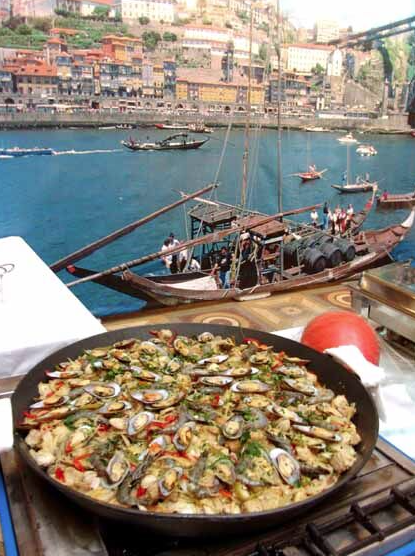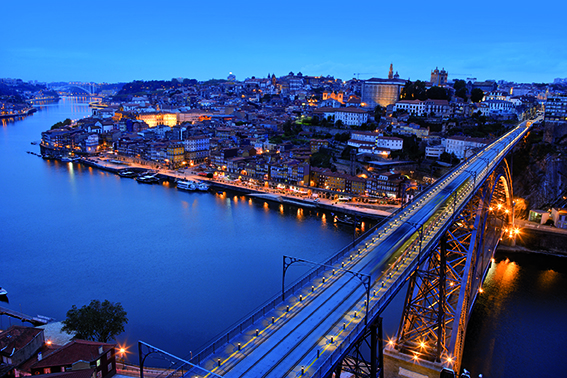Portugal, Windmills, Food and Adventure

By Jon Haggins Photography by David Fasano
If you want to discover a peaceful, historic region, you must visit Montalegre, where there are rolling mountains, plains, a fresh water lake that runs to a damn providing energy and a beautiful village sitting at the edge of the lake.
Montalegre is the most northern point of Portugal next to the border of Galicia, Spain. The Peneda-Geres National Park is a mountainous area lined with floral scents that divides Portugal from Spain. Windmills are perched on the apex of the mountain and the mountains dip into sweet valleys. Montalegre, a municipality in northern Portugal located on the district of Vila Real is one of the two municipalities that comprise the Barroso region.
Its people are very hospitable and it’s a peaceful destination with lots of adventure and history. Local firemen treated us to a boat ride on the calm lake and surprised us with local treats and of course great wine. The region does not produce wine; but the locals certainly drink it.
Montalegre is a quaint village; its buildings are constructed of sand stone. It was once a mining town and now they are restoring the mines and converting them into museums. The Montalegre Castle is a Portuguese National Monument. An ancient vestige of punishment, Pellourinho whipping block, stands in the center of the town square. It’s a historic village where cows parade along the narrow cobble stone streets and stop to quench their thirst from a large stone basin of fresh water. Locals also collect water from the basin for their animals.

The region produces beef that melts in your mouth and some of the freshest dishes can be found in Tasca do Acouque Restaurant.
The Eco Museum is an interactive museum with displays of the history of the region from its farm tools and festival costumes.
Barraso village is known for bull fighting and it’s the most popular sport in the region. It’s where bulls compete against each other; unlike Spain the bulls are not killed. The bulls can return the next month for another fight. There is even a statue of two bulls in the square.
Sexta Feira 13 or Friday the 13th celebration is a festival of costume, fireworks and parades and Queimada drink (fire drink). It is thought to have originated in ancient times when Celts established villages and settled in the region of Galicia. It’s made with orujo; a strong liqueur similar to grappa, much of the alcohol is burned off in the flames. The drink is only served during Friday the 13th celebrations.
Lomego is a small village in Northern Portugal’s Douro Region. At the end of a grand boulevard stands a fountain and at 686 steps to the top of the hill is a small baroque church.
Lamego’s Gothic Cathedral is located right in the center of downtown, a national monument since 1910. It was built in the 12th Century by Portugal’s first king, Afonso Henriques, and was extensively rebuilt in the 16th and 18th Centuries. The bell tower is all that remains of the original construction. The vaulted ceilings were painted by Nicolau Nasoni in the first half of the 18th Century. The marble and gilt altarpiece is also 18th Century, and the organs are from 1753. The cloisters and chapels are 16th Century. The cathedral is a gothic design and it has an enormous inner patio that is so tranquil you can hear the birds and bees.
Bishop D. Joao Camelo de Madureira hired artist Vasco Fernandes in 1506, who became be known by the sobriquet Grao Vasco, to accomplish a monumental alter piece for the high alter. Initially composed of 20 panels, there are only five remaining today at the Museu de Lamego. The cathedral is filled with artifacts, gold and religious painting and sculptures. Restorers are diligently working on artifacts from the chapel.

The entrance gate to Mateus Palace is a very grand structure and just beyond the gate is a lush park. Before arriving at the Palace lies a shallow pond with a statue of a lady resting on her side. The palace was built in the first half of the 18th Century in Baroque style by an Italian architect. Mateus Palace is now a museum of a splendid period; it houses artifacts, art, history, tapestry, silverware, statues and paintings. The 7th Count still resides in the palace in the private area. Touches of religious artifacts and the orient can be seen throughout the palace and long hallways are embellished with furnishing and vases.
Manjar do Douro Restaurant is one of finest restaurant in Lomego. It’s where they serve traditional lamb, veal and local wines from the Douro region.
The Monastery of Santa Maria de Salzedas has in its collection works by some of the biggest names in painting in Portugal: Vasco Fernandes, Bento Coelho da Silveira and Pascal Parente. One of the paintings includes a Unicorn and it is believed that the virgin brought the Unicorn to the world.
Almeida is one of the most impressive defensives of the Iberian Peninsula, having had an important role in the struggles against Spain and in the heroic opposition to the French invasions of the early 19th century. The five point San Franciso Fort offers horse and carriage rides. Men dressed in traditional capes representing The Brotherhood of Gastronomy welcome visitors.
Irene Restaurant is a family run establishment where Irene herself prepares all the meals. It’s a great way to celebrate and just have good old fashion fun in the O Picadeiro d’el Rey stables where one can ride a horse, a motorcycle or visit the stable.
The Douro Region is magical. The railway line of the Douro took 12 years to build between Porto and Barca D’alva containing in its route 22 tunnels and 35 bridges. This is an old fashion train that will take you from Pocinho to Pinhao.
It’s a lively trip passing river cruises, winding wine terraces on the side of the mountains. The Douro River twists and winds through the valley. The train is a scenic tour passing riverboat cruises and olive trees and rolling mountains terraces of grape vines that remind me of knitted sweaters.
Pinhao, a quaint village where the train station is lined with Talavera tiles (typical Portuguese tiles).
The double-decker bus brings us closer to the fruits of the valley. I visited Quinta das Carvalhas, Quinta do seixo and Quinta do Vallado to taste and learn about wine making. Wine is the essence of life in the Douro Valley.
Porto is the second largest city in Portugal after Lisbon, located along the Douro river estuary in northern Portugal. It’s an impressive city where the Douro River runs through and divides the city into Porto and Vila Gaia. The town gave Port wine its name. Porto is filled with wine history and great people.
Porto is magical; it’s one of the oldest European centers and registered as a UNESCO World Heritage site since 1996. Its settlement dated back many centuries to when it was an outpost of the Roman Empire. Porto is a scenic city where the river and the buildings reflect its history. There are many restaurants and cafés along the riverfront with the great views of either side of the river.
Traditionally wine was taken down the river in flat bottom boats known as Rebelos, to be stored in barrels in cellars in Vila Gaia, which is just across the river from Porto. Dams were built in 1950-60 along the river ending river traffic on the Spanish border section, so today wine is transported in tanker trucks. These boats are a popular tourist attraction to tour up and down the Douro River. This is the best way to see the city, relax and sip port. The architecture rises from the river to the top of the hills. The view from the river reminds me of an impressionist painting.

Charm, charm, charm is what Porto is all about. The double-decker bus is another popular tour of Porto where it takes you through narrow cobble stone streets. Around every corner is another treasure of the city with many Baroque churches scattered throughout the city. Another charm of the city is the trolley cars. A number of old buildings are decorated with Talavera tiles.
The residential area shows off a collection of beautiful homes and wide boulevards. There are many parks and plazas scattered throughout the city. Porto has a beach at the edge of the city where everyone is active. There are many parks and plazas scattered about the city. Porto has a beach at the edge of the city with an old fort standing at the edge of the beach. There is also a lighthouse on the apex of the city.
The bridge connects the city of Porto to Vila Gaia designed by Gustave Eiffel; the same engineer who designed the Eiffel Tower in Paris. The subway and cars use this bridge and there’s also a pedestrian walk.
Villa Gaia sits on the opposite side of the bridge and has a spectacular view of Porto and the cafés along the riverfront. Cable cars rise high above Vila Gaia from the top of the hill.
Calem winery has one of largest barrels of wine, filled with 14,648 gallons of a ten-year tawny. Calem cellar wine tasting is an experience not to be missed.
Porto Cruz Winery serves the best lunch in its dining room. Porto is a real surprise and a gift of architecture, because around every corner is a treasure and history to be discovered.
Porto a colorful landscape is truly a painter’s dream. UNESCO was so right when they designated the city as a world heritage site. Around every corner is another beautiful scene. Rua Galeria da Paris is very alive for nightlife and Fado music, similar to American Blues, the Portuguese version of the Blues.
Editor’s Note:Check out Jon’s interestingly named book Chasing Wild ASS. Oooooh, it’s not what you’re thinking. Chasing Wild ASS is a narrative of Jon’s travels to more than 60 countries around the world. The title came about while chasing jackasses in Kutch Wild Ass Sanctuary in Gujarat, India. Chasing Wild ASS will entertain and offer tips to massage your soul. It’s a celebration of life. Be the first to get an autographed copy. 489 pages including color photos and recipes.
Paperback | $19.95 plus $5.00 S&H
Jon Haggins |
PO Box 20902
New York City, NY 10023


